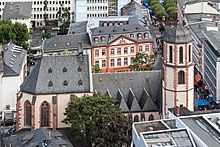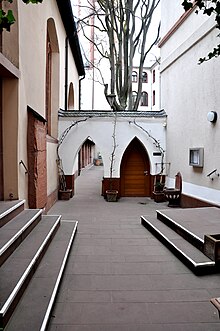Liebfrauenkirche (Frankfurt am Main)
The Liebfrauenkirche is a Gothic church on Liebfrauenberg in the northern old town of Frankfurt am Main . It was built in several construction phases from the 14th to the 16th century and today serves as a monastery - and as a Catholic rectorate church. Due to its location near the Zeil , it has an important role in the inner city pastoral care; the church and the publicly accessible cloister courtyard are popular as a place of silence beyond the Catholic community.
Location and surroundings
The Liebfrauenkirche is located on the northern edge of the Liebfrauenberg , one of the most important squares in the old town in the Middle Ages . The Staufen wall, a city wall from the 12th century , ran along the church . It was not until 1855 that the Liebfrauengasse was laid west of the church as a road breakthrough to the Zeil , creating a direct connection from Liebfrauenberg to Neustadt . Therefore, the church portal opens to the south, although the church has the usual east-west orientation. There is no door in the west wall of the church, instead a remnant of the old Staufen wall can still be seen here today.
The Neue Kräme , one of the three north-south axes of the old town, runs south from Liebfrauenberg . Like Liebfrauengasse, it has been a pedestrian zone since the 1960s and connects Liebfrauenberg with Paulsplatz and Römerberg , from where the Fahrtor leads to the banks of the Main .
history
At the beginning of the 14th century, most of the properties at what was then Rossebühel , later known as Liebfrauenberg, which was first mentioned in a document in 1280, were owned by the wealthy Wanebach family from Frankfurt . In 1318, the then head of the family, the patrician Wigel von Wanebach , whose epitaph from 1322 is still in the church today, together with his son-in-law Wigel Frosch and their wives, founded a small chapel there . According to documentary reports, it was probably completed by 1321 at the latest and initially equipped with six vicarages .
Wigel von Wanebach died soon afterwards in the winter of 1322, Wigel Frosch followed him in 1324. The widows expanded the foundation against the resistance of the rest of the relatives and in 1325 achieved that the chapel was elevated by the Archbishop of Mainz, Matthias von Buchegg, to the collegiate church of Our Lady with six prebenders . After the Bartholomäusstift , which dates back to the Carolingian era, and the collegiate monastery at the Leonhardskirche founded in 1317 , the city received its third chapter. The founding phase of the Church of Our Lady ends with the death of the widows in 1326 and 1335, who shortly beforehand again provided richly for the church and monastery.
In 1344 the small building was extended to the west to a three-aisled Gothic hall church , which is evident from a corresponding consecration message. This also mentions two altars. In 1393, a document already mentions three altars, including an older high altar consecrated to the Mother of God.
From 1415 the south facade of the church was redesigned. The most important architectural ornament of the church, a tympanum with the Adoration of the Kings from Madern Gerthener's workshop, dates from this period . In 1453 the City Council allowed the monastery to convert a tower of the Frankfurt city fortifications west of the church into a bell tower. From 1506 to 1509 Jörg Östereicher extended the nave and enlarged the choir .
From 1520 to 1530 Johannes Cochläus was dean of the Liebfrauenstift. Even after the Reformation was introduced in Frankfurt in 1533, it remained Catholic and under the jurisdiction of the Archbishops of Mainz .
1763–1771 the church was comprehensively redesigned in Baroque style, which still shapes its external appearance today. Due to dilapidation, the old tower hood was torn off and replaced by the shape that can now be seen. Before that, there had been a long and ultimately fruitless dispute for the monastery about a simultaneous elevation of the tower between the responsible Kurmainz and the city. In the years before that, the church received an almost completely new interior in the Rococo style, which was the most important ensemble of its kind in the city. The old altars were removed or relocated and replaced by five new ones from Mainz workshops, including the high altar. At the same time a new organ was procured from the workshop of the Frankfurt organ maker Ernst Weegmann. In 1771 the refurbishment was completed with the arrival of the new pulpit, also from Mainz.
During the secularization of 1803, ownership of the church fell to the city of Frankfurt; Since then it has been one of the endowment churches , for the maintenance of which the municipality has to take care of. In 1824 Friedrich Rumpf built a new entrance hall in front of the Gerthener Dreikönigsportal.
In 1923, pastoral care at the Church of Our Lady was taken over by the Capuchins , who set up a convent north of the church. The Capuchins had already owned a church on the site of the former Antoniterhof in Töngesgasse from 1723 to 1803 .
On March 22, 1944, a heavy air raid hit Frankfurt's historic old town. The Liebfrauenkirche also burned down completely and the neighboring monastery was badly damaged. Much of the valuable furnishings, including all nine altars, the pulpit, the late Gothic choir stalls and the Walcker organ from 1864 were destroyed. Only a small part, including fragments of the high altar and a statue of the Virgin Mary, which stood in a niche in the outer church wall facing the cloister courtyard, could be saved.
After the end of the war, the church choir was given an emergency roof so that it could be used again temporarily for church services. The rest of the church remained in ruins for more than ten years until it was rebuilt in 1955/56.
From 2017 to 2019, the city of Frankfurt had the church extensively renovated. The mosaic Way of the Cross , which had been covered in the meantime, was uncovered and restored by Ludwig Becker . The old main entrance at the south portal in front of the Epiphany tympanum has been reopened. On June 16, 2019, Bishop Georg Bätzing consecrated the new altar of the Liebfrauenkirche.
organ
The organ was built in 2008 by the organ builder Karl Göckel (Mühlhausen-Rettigheim). The instrument has 57 registers (3370 pipes) on three manuals and a pedal . The prospectus is dominated by the main work . Swell and Recit are inside the case. The swell is arranged in the German-romantic style, the swellable recit in the French-romantic style. A special feature is the auxiliary unit and the satellite unit with the function of a remote unit which is controlled by radio and which accompanies the cantor or choir singing. Both works can be freely coupled to all manuals and the pedal of the organ.
|
|
|
|
|
|||||||||||||||||||||||||||||||||||||||||||||||||||||||||||||||||||||||||||||||||||||||||||||||||||||||||||||||||||||||||||||||||||||||||||||||||||||||||||||||||||||||||||||||||||||||||||||||||||||||
-
Couple
- Normal coupling: II / I, III / I, III / II, I / P, II / P, III / P
- Super octave coupling: I / I, II / I, III / I, III / III
- Sub-octave coupling: II / I, III / I, II / II, III / III
Spiritual life
Until December 31, 2013, the Liebfrauenkirche was both the monastery church of the Capuchin monastery of Liebfrauen and the parish church. Since the beginning of 2014 it has been a “monastery and rectorate church” without its own congregation. It has meanwhile developed into a spiritual center in the Rhine-Main area . The church is open daily from 5:30 a.m. to 9:00 p.m., and thus longer than any other church in Frankfurt.
In the neighboring Franziskustreff , Capuchin Brothers and volunteers have been offering food to the homeless and needy people at low prices since 1991. On the west side of the church is the Punctum information center of the Association of Catholic Churches in Frankfurt am Main .
During Advent, the central location in the middle of the Frankfurt Christmas market is used to invite guests to an Advent concert with changing musicians or choirs every day at 7:30 p.m. The saint of the day is remembered. In the inner courtyard, the courtyard of silence invites you to reflect in the midst of the hustle and bustle of the big city.
On weekdays there are three Eucharistic celebrations and Vespers (evening praise) with sacramental blessings. The ecumenical midday prayer has been taking place in the neighboring Evangelical Katharinenkirche since 2018 . There are four Eucharistic celebrations on Sundays.
Bells
When it was rebuilt in 1954, the Liebfrauenkirche received five church bells from the foundry Gebr. Rincker with a total weight of 3619 kg. The angelus bell , which was cast by Benedict and Johann Schneidewind in Frankfurt in 1745, hangs in the roof turret on the church choir. As the only bell in the church, it is not part of the Frankfurt city bells .
|
No. |
Surname |
Casting year |
Foundry, casting location |
Diameter (mm) |
Weight (kg) |
Nominal (16th note) |
Inscription (Latin) |
| 1 | Joseph | 1954 | Gebr. Rincker, Sinn | 1325 | 1495.5 | e 1 -4 | "St. Joseph. Make us lead an innocent life. " |
| 2 | Maria | 1954 | Gebr. Rincker, Sinn | 1115 | 883 | g 1 -2 | "St. Maria. May the Virgin Mary bless us with the divine child. " |
| 3 | Francis | 1954 | Gebr. Rincker, Sinn | 1000 | 632.5 | a 1 -2 | "St. Francis. My God and everything. " |
| 4th | Boniface | 1954 | Gebr. Rincker, Sinn | 832 | 355 | c 2 -1 | "St. Boniface. You will be my witnesses to the end of the earth. " |
| 5 | Elisabeth | 1954 | Gebr. Rincker, Sinn | 745 | 253 | d 2 -3 | "St. Elisabeth. Blessed are the merciful, for they will receive mercy. " |
| 6th | Angelus | 1745 | Benedict & Johann Schneidewind, Frankfurt | 610 | 129 | e 2 -7 | "Hear the resounding ore, you holy crowd of the people, come at its sound, may the voices of God's praise ring out." |
literature
- Wolf-Christian Setzepfandt : Architecture Guide Frankfurt am Main / Architectural Guide . 3. Edition. Dietrich Reimer Verlag, Berlin 2002, ISBN 3-496-01236-6 , p. 5 (German, English).
- State Office for Monument Preservation Hessen (Hrsg.): Kath. Liebfrauenkirche In: DenkXweb, online edition of cultural monuments in Hessen
Web links
- Internet presence of the church and the Capuchin monastery Liebfrauen in Frankfurt a. M.
- Church location Liebfrauen on the website of the Cathedral Parish of St. Bartholomew
- The Liebfrauenkirche. altfrankfurt.com
- The organ from Karl Göckel, Münstersches Orgelmagazin
- Festschrift for the inauguration of the Göckel organ on August 9, 2008, Liebfrauenkirche
- "The Liebfrauenberg in Frankfurt seen from the west, 1827". Historical town views, plans and floor plans. In: Landesgeschichtliches Informationssystem Hessen (LAGIS).
- State Office for Monument Preservation Hessen (Hrsg.): Kath. Liebfrauenkirche In: DenkXweb, online edition of cultural monuments in Hessen
Individual evidence
- ↑ Freed from soot: Liebfrauen offers unknown treasures , accessed on June 15, 2019
- ↑ Detailed information on the new organ on the municipality's website
- ↑ Christophorus Goedereis: The Liebfrauenkirche has had a new canonical status since January 1, 2014. In: liebfrauen.net. Retrieved January 14, 2014 .
- ^ Franziskustreff
- ^ Punctum
Coordinates: 50 ° 6 ′ 47 " N , 8 ° 40 ′ 53" E







